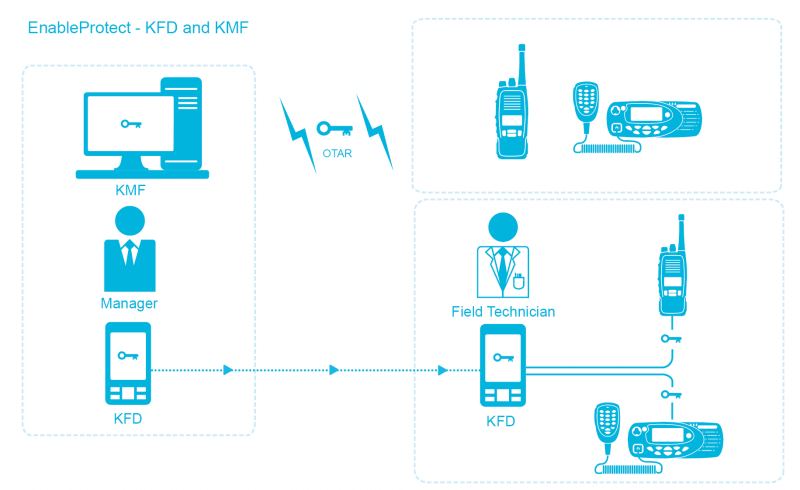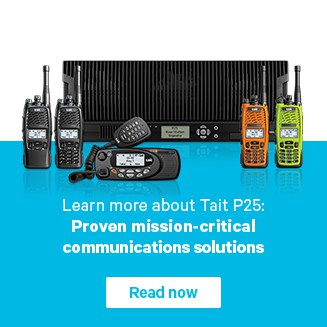Introduction to P25
Call Types and Features
P25 Data Calls
In addition to voice calls, the P25 network supports a wide range of data calls.
Status Messages
Status messages have been used in radio communications for many years and P25 supports the use of status messages. A pre-programmed list of text messages is configured into the radio units and the dispatch console. Rather than sending a voice call to update the status of the job, a status message can be quickly sent.
Status messages work well for teams that have a standard set of situation updates that need to be reported. For example, when a call-out is made officers may need to alert dispatch when they have left the station, once they are on-site, and once again when the job is complete.
Status messages could also be used for features such as sending a callback request to a dispatcher.
Packet Data Calls
In addition to sending status messages, the P25 standard also allows for a radio or dispatcher to query the status of another radio. P25 also supports packet data calls. Instead of the P25 radio channel carrying packets of digital voice, it can be used to carry packets of data from applications inside the radio, or devices connected to the radio. A typical way of using this ability is IP packet data, where the P25 radio is given an IP address just like a PC on a computer network.
The dispatcher or comms center can then use IP-connected data applications to send and receive data to and from field units. There are a few standard applications that allow multiple radio manufacturers to support the same servers. However, there’s also scope to create a wide range of custom applications to meet the specific requirements of your organization.
1) Location Updates using GPS: One of the standard applications are location updates using GPS. Identifying a radio user’s location can be an essential safety feature when working in life-threatening situations.
It can also be a valuable time and money saver in commercial applications. Many P25 radios available today have GPS built in, and enabling location updates may be as simple as enabling a software feature.
There is a wide range of Automatic Vehicle Location (AVL) applications available. These can be chosen to suit the application; whether that be sending updates to a central comms center, or sending a location update as part of an emergency call to a command vehicle in the field.
2) OTAR: In other videos we discussed how encryption is an important feature of P25. One of the problems with encryption is how to update the key in a fleet of radios already deployed in the field. A small tactical team can come together at the start of an operation and load a key with a cable connected key loader, but if a fleet of hundreds of radios is to be updated it can be very difficult to physically touch each of the radios with a key-loader.
Over the air rekeying (OTAR) provides a secure way to send out new encryption keys over the air. This makes it easier to implement a key management plan that requires updating of encryption keys on a regular basis or the rapid replacement of a key if a radio has been lost or stolen.
3) OTAP: Another feature provided by P25 radios using packet data is the ability to reprogram them over the air. Over the air reprogramming (OTAP) is a powerful way to manage large fleets of radios. If a new group, channel, or feature is added to the network, all the deployed radios can be reprogrammed remotely, rather than having to bring them into a central site, or send someone out to go round all of the radios and reprogram them.
Radio Check
Other features provided by the P25 standard that don’t require the use of packet data. One of these features is a radio check. This is a way for a dispatcher to check on the availability of a radio unit. This can help identify if a called party is not responding because they’re out of coverage, or if the call is getting through to their radio, but they’re still not responding.
Call Alert
Another feature is call alert, and this works similar to paging. Rather than voice-calling a radio and asking if that person is available, a call alert is made, the radio beeps and displays the ID of the caller, and the person receiving the call alert can then call them back.
Inhibit and Uninhibit
Another powerful feature is the ability to inhibit and uninhibit the radio remotely. This feature can be essential if encryption is used. If a radio is lost or stolen and it has the encryption keys, someone with their radio could listen to the secure calls. The ability to inhibit that radio and receive feedback that the command was successful provides confidence that the lost radio is disabled and cannot be used to make or receive calls. If that radio is later recovered, it can be uninhibited and returned to service.
This can also be useful for vehicle maintenance or the transporting of radios from place to place. The radio can be configured and ready for use but inhibited, preventing unauthorized use until it has been received by the authorized user of that radio.
Many of these features are intended to replace existing features used by public safety on analog radio networks. This allows easy migration to P25. Some features, however, are new enhancements that can be used to improve operations or the management of the radio network.
While this is not a complete list of all the P25 data calls, we hope it is a good starting point to understand how a P25 radio system could be used.
 Radio Academy
Radio Academy






